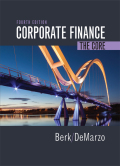
EBK CORPORATE FINANCE
4th Edition
ISBN: 8220103164535
Author: DeMarzo
Publisher: PEARSON
expand_more
expand_more
format_list_bulleted
Concept explainers
Textbook Question
Chapter 10, Problem 34P
Suppose the risk-free interest rate is 4%.
- a. i. Use the beta you calculated for the stock in Problem 33(a) to estimate its expected return.
ii. How does this compare with the stock’s actual expected return?
- b. i. Use the beta you calculated for the stock in Problem 33(b) to estimate its expected return.
ii. How does this compare with the stock’s actual expected return?
Expert Solution & Answer
Want to see the full answer?
Check out a sample textbook solution
Students have asked these similar questions
How to rewrite the problem statement, correcting the identified errors of the Business Problem Information and the current Bank Problem Statement (for the discussion: Evaluating a Problem Statement)
Don't used hand raiting and don't used Ai solution
3 years ago, you invested $9,200. In 3 years, you expect to have $14,167. If you expect to earn the same annual return after 3 years from today as the annual return implied from the past and expected values given in the problem, then in how many years from today do you expect to have $28,798?
Chapter 10 Solutions
EBK CORPORATE FINANCE
Ch. 10.1 - For an investment horizon from 1926 to 2012, which...Ch. 10.1 - For an investment horizon of just one year, which...Ch. 10.2 - Prob. 1CCCh. 10.2 - Prob. 2CCCh. 10.3 - How do we estimate the average annual return of an...Ch. 10.3 - Prob. 2CCCh. 10.4 - Prob. 1CCCh. 10.4 - Do expected returns of well-diversified large...Ch. 10.4 - Do expected returns for Individual stocks appear...Ch. 10.5 - What is the difference between common risk and...
Ch. 10.5 - Prob. 2CCCh. 10.6 - Explain why the risk premium of diversifiable risk...Ch. 10.6 - Why is the risk premium of a security determined...Ch. 10.7 - What is the market portfolio?Ch. 10.7 - Define the beta of a security.Ch. 10.8 - Prob. 1CCCh. 10.8 - Prob. 2CCCh. 10 - The figure on page informalfigure shows the...Ch. 10 - Prob. 2PCh. 10 - Prob. 3PCh. 10 - Prob. 4PCh. 10 - Prob. 5PCh. 10 - Prob. 6PCh. 10 - The last four years of returns for a stock are as...Ch. 10 - Prob. 9PCh. 10 - Prob. 10PCh. 10 - Prob. 11PCh. 10 - How does the relationship between the average...Ch. 10 - Consider two local banks. Bank A has 100 loans...Ch. 10 - Prob. 21PCh. 10 - Prob. 22PCh. 10 - Consider an economy with two types of firms, S and...Ch. 10 - Prob. 24PCh. 10 - Explain why the risk premium of a stock does not...Ch. 10 - Prob. 26PCh. 10 - Prob. 27PCh. 10 - What is an efficient portfolio?Ch. 10 - What does the beta of a stock measure?Ch. 10 - Prob. 31PCh. 10 - Prob. 32PCh. 10 - Prob. 33PCh. 10 - Suppose the risk-free interest rate is 4%. a. i....Ch. 10 - Prob. 35PCh. 10 - Prob. 36PCh. 10 - Suppose the market risk premium is 6.5% and the...Ch. 10 - Prob. 38P
Knowledge Booster
Learn more about
Need a deep-dive on the concept behind this application? Look no further. Learn more about this topic, finance and related others by exploring similar questions and additional content below.Similar questions
- What is the value at the end of year 3 of a perpetual stream of $70,000 semi-annual payments that begins at the end of year 7? The APR is 12% compounded quarterly.arrow_forwardFirm A must pay $258,000 to firm B in 10 years. The discount rate is 16.44 percent per year. What is the present value of the cash flow associated with this arrangement for firm A? -I got the answer of 56331.87773=56332 (rounded to the nearest dollar), but it says incorrect.arrow_forwardSuppose you have two histograms: one where the mean equals the median, and one where the mean is different from the median. How would you expect the two histograms to differ.arrow_forward
arrow_back_ios
SEE MORE QUESTIONS
arrow_forward_ios
Recommended textbooks for you
 EBK CONTEMPORARY FINANCIAL MANAGEMENTFinanceISBN:9781337514835Author:MOYERPublisher:CENGAGE LEARNING - CONSIGNMENT
EBK CONTEMPORARY FINANCIAL MANAGEMENTFinanceISBN:9781337514835Author:MOYERPublisher:CENGAGE LEARNING - CONSIGNMENT Intermediate Financial Management (MindTap Course...FinanceISBN:9781337395083Author:Eugene F. Brigham, Phillip R. DavesPublisher:Cengage Learning
Intermediate Financial Management (MindTap Course...FinanceISBN:9781337395083Author:Eugene F. Brigham, Phillip R. DavesPublisher:Cengage Learning

EBK CONTEMPORARY FINANCIAL MANAGEMENT
Finance
ISBN:9781337514835
Author:MOYER
Publisher:CENGAGE LEARNING - CONSIGNMENT

Intermediate Financial Management (MindTap Course...
Finance
ISBN:9781337395083
Author:Eugene F. Brigham, Phillip R. Daves
Publisher:Cengage Learning
Portfolio return, variance, standard deviation; Author: MyFinanceTeacher;https://www.youtube.com/watch?v=RWT0kx36vZE;License: Standard YouTube License, CC-BY